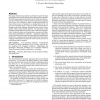Free Online Productivity Tools
i2Speak
i2Symbol
i2OCR
iTex2Img
iWeb2Print
iWeb2Shot
i2Type
iPdf2Split
iPdf2Merge
i2Bopomofo
i2Arabic
i2Style
i2Image
i2PDF
iLatex2Rtf
Sci2ools
SIGGRAPH
2000
ACM
2000
ACM
Pose space deformation: a unified approach to shape interpolation and skeleton-driven deformation
Pose space deformation generalizes and improves upon both shape interpolation and common skeleton-driven deformation techniques. This deformation approach proceeds from the observation that several types of deformation can be uniformly represented as mappings from a pose space, defined by either an underlying skeleton or a more abstract system of parameters, to displacements in the object local coordinate frames. Once this uniform representation is identified, previously disparate deformation types can be accomplished within a single unified approach. The advantages of this algorithm include improved expressive power and direct manipulation of the desired shapes yet the performance associated with traditional shape interpolation is achievable. Appropriate applications include animation of facial and body deformation for entertainment, telepresence, computer gaming, and other applications where direct sculpting of deformations is desired or where real-time synthesis of a deforming mode...
Computer Graphics | Deformation Approach Proceeds | Shape Interpolation | SIGGRAPH 2000 | Space Deformation Generalizes |
| Added | 25 Aug 2010 |
| Updated | 25 Aug 2010 |
| Type | Conference |
| Year | 2000 |
| Where | SIGGRAPH |
| Authors | John P. Lewis, Matt Cordner, Nickson Fong |
Comments (0)

